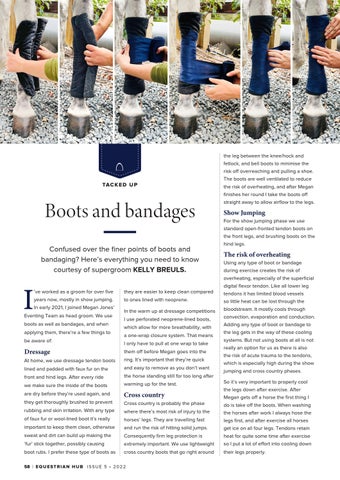the leg between the knee/hock and fetlock, and bell boots to minimise the risk off overreaching and pulling a shoe. The boots are well ventilated to reduce
TAC K E D U P
Boots and bandages
the risk of overheating, and after Megan finishes her round I take the boots off straight away to allow airflow to the legs.
Show Jumping For the show jumping phase we use standard open-fronted tendon boots on the front legs, and brushing boots on the
Confused over the finer points of boots and bandaging? Here’s everything you need to know courtesy of supergroom KELLY BREULS.
I
hind legs.
The risk of overheating Using any type of boot or bandage during exercise creates the risk of overheating, especially of the superficial digital flexor tendon. Like all lower leg
’ve worked as a groom for over five
they are easier to keep clean compared
tendons it has limited blood vessels
years now, mostly in show jumping.
to ones lined with neoprene.
so little heat can be lost through the
In the warm up at dressage competitions
bloodstream. It mostly cools through
I use perforated neoprene-lined boots,
convection, evaporation and conduction.
In early 2021, I joined Megan Jones’
Eventing Team as head groom. We use boots as well as bandages, and when applying them, there’re a few things to be aware of:
which allow for more breathability, with a one-wrap closure system. That means I only have to pull at one wrap to take
Dressage
them off before Megan goes into the
At home, we use dressage tendon boots
ring. It’s important that they’re quick
lined and padded with faux fur on the
and easy to remove as you don’t want
front and hind legs. After every ride
the horse standing still for too long after
we make sure the inside of the boots
warming up for the test.
are dry before they’re used again, and
Cross country
they get thoroughly brushed to prevent
Adding any type of boot or bandage to the leg gets in the way of these cooling systems. But not using boots at all is not really an option for us as there is also the risk of acute trauma to the tendons, which is especially high during the show jumping and cross country phases. So it’s very important to properly cool the legs down after exercise. After Megan gets off a horse the first thing I
Cross country is probably the phase
rubbing and skin irritation. With any type
do is take off the boots. When washing
where there’s most risk of injury to the
the horses after work I always hose the
of faux fur or wool-lined boot it’s really
horses’ legs. They are travelling fast
legs first, and after exercise all horses
important to keep them clean, otherwise
and run the risk of hitting solid jumps.
get ice on all four legs. Tendons retain
sweat and dirt can build up making the
Consequently firm leg protection is
heat for quite some time after exercise
‘fur’ stick together, possibly causing
extremely important. We use lightweight
so I put a lot of effort into cooling down
boot rubs. I prefer these type of boots as
cross country boots that go right around
their legs properly.
58 | E Q U E S T R I A N H U B I S S U E 5 • 2 0 2 2
























